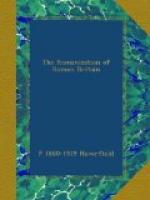about which it adds very few details. But in the
case of Britain it notes the municipal rank of the
various
coloniae, and it further appends tribal
names to nine or ten town-names, which are thus distinguished
from all other British place-names. For example,
we have Venta Belgarum (Winchester), not Venta simply;
Corinium Dobunorum (Cirencester), not Corinium simply.
The towns thus specially marked out are just those
towns which are also declared by their actual remains
to have been the chief country towns of Roman Britain.
This coincidence can hardly be an accident. We
may infer that the towns to which the Ravennas appends
tribal names were the cantonal capitals of the districts
of Roman Britain, and that a list of them, perhaps
mutilated and imperfect, has been preserved by some
chance in this late writer. In other words, the
larger part of Roman Britain was divided up into districts
corresponding to the territories of the Celtic tribes;
each had its capital, and presumably its magistrates
and senate, as the above-mentioned inscription shows
that the Silures had at Venta Silurum. We may
suppose, indeed, that the district magistrates—the
county council, as it would now be called—were
also the magistrates of the country town. The
same cantonal system, then, existed here as in northern
Gaul. Only, it was weaker in Britain. It
could not impose tribal names on the towns, and it
went down easily when the Empire fell. In Gaul,
Lutetia Parisiorum became Parisiis and is now Paris,
and Nemetacum Atrebatum became Atrebatis and is now
Arras. In Britain, Calleva Atrebatum (Silchester)
remained Calleva, so far as we know, till it perished
altogether in the fifth century.[4]
[Footnote 1: Found at Venta Silurum (Caerwent)
in 1903: ... leg. legi[i] Aug. proconsul(i)
provinc. Narbonensis, leg. Aug. pr. pr. provi.
Lugudunen(sis): ex decreto ordinis respubl(ica)
civit(atis) Silurum—a monument erected
by the cantonal senate of the Silures to some general
of the Second legion at Isca Silurum, twelve miles
from Caerwent—perhaps to Claudius Paulinus,
early in third century (Athenaeum, Sept. 26,
1903; Archaeologia, lix. 120; Eph. ix.
1012). Other inscriptions mention a civis Cantius,
a civitas Catuvellaunorum and the like, but
their evidence is less distinct.]
[Illustration: FIG. 20. INSCRIPTION FOUND
AT CAERWENT (VENTA SILURUM) MENTIONING A DECREE OF
THE SENATE OF THE CANTON OF SILURES.]
[Footnote 2: Icinos in Itin. Ant.
474. 6 may well be Venta Icenorum (Victoria Hist.
of Norfolk, i. 286, 300).]
[Footnote 3: Canterbury may seem an exception.
But its name comes ultimately from the Early English
form of Cantium, not from the Cantii. In the
south-west and in Wales, tribal names like Dumnonii
(Devonshire), Demetae, Ordovices, have lingered on
in one form or another, and, according to Professor
Rhys, Bernicia is derivable from Brigantes. But
these cases differ widely from the Gaulish instances.]




